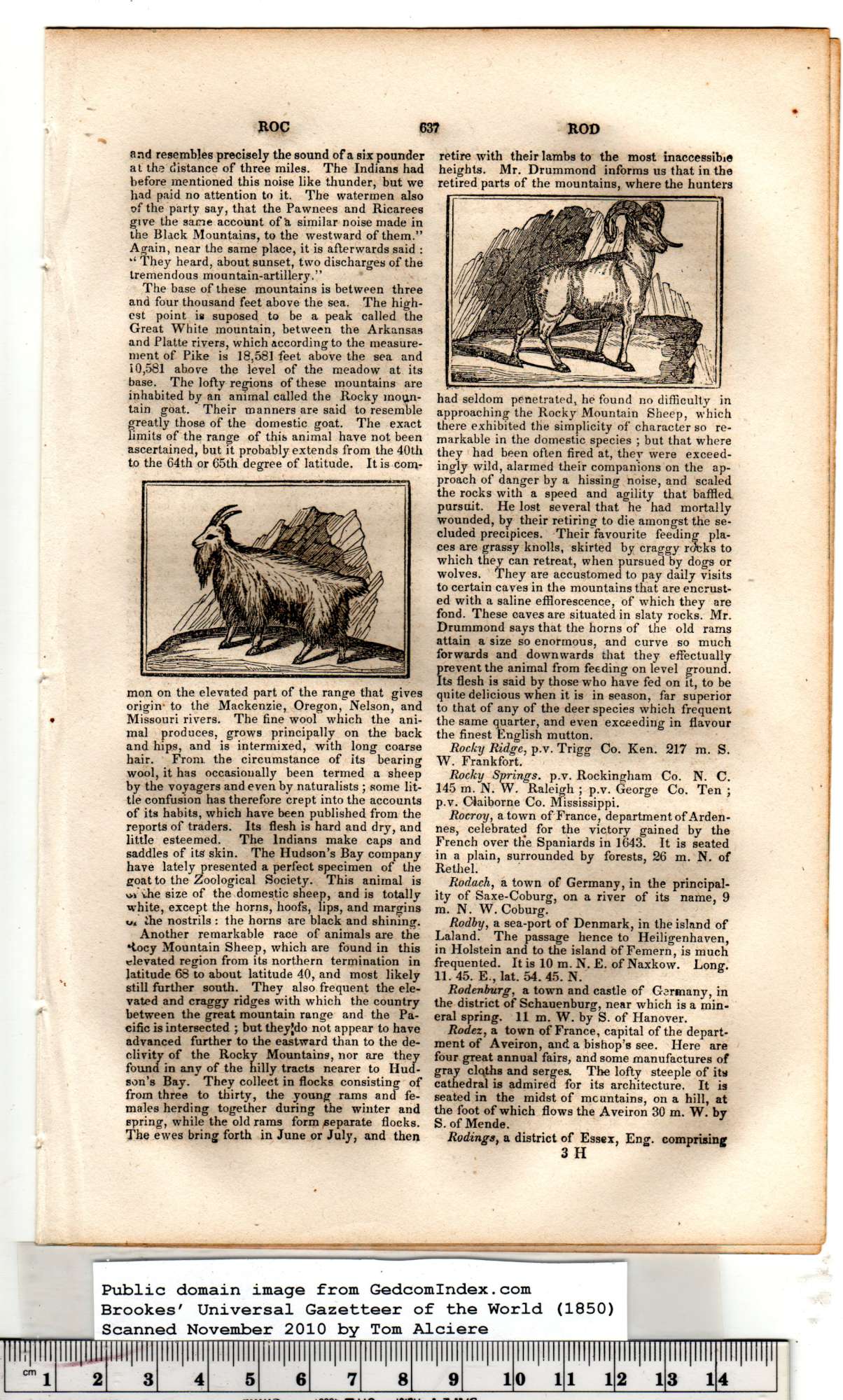|
and resembles precisely the sound of a six pounder
at the distance of three miles. The Indians had
before mentioned this noise like thunder, but we
had paid no attention to it. The watermen also
of the party say, that the Pawnees and Ricarees
give the same account of'a similar noise made in
the Black Mountains, to the westward of them.”
Again, near the same place, it is afterwards said :
They heard, about sunset, two discharges of the
tremendous mountain-artillery.”
The base of these mountains is between three
and four thousand feet above the sea. The high-
est point is suposed to be a peak called the
Great White mountain, between the Arkansas
and Platte rivers, which according to the measure-
ment of Pike is 18,581 feet above the sea and
10,581 above the level of the meadow at its
base. The lofty regions of these mountains are
inhabited by an animal called the Rocky moun-
tain goat. Their manners are said to resemble
greatly those of the domestic goat. The exact
limits of the range of this animal have not been
ascertained, but it probably extends from the 40th
to the 64th or 65th degree of latitude. It is com-
mon on the elevated part of the range that gives
origin- to the Mackenzie, Oregon, Nelson, and
Missouri rivers. The fine wool which the ani-
mal produces, grows principally on the back
and hips, and is intermixed, with long coarse
hair. From, the circumstance of its bearing
wool, it has occasionally been termed a sheep
by the voyagers and even by naturalists ; some lit-
tle confusion has therefore crept into the accounts
of its habits, which have been published from the
reports of traders. Its flesh is hard and dry, and
little esteemed. The Indians make caps and
saddles of its skin. The Hudson’s Bay company
have lately presented a perfect specimen of the
goat to the Zoological Society. This animal is
vxc2xbbv the size of the domestic sheep, and is totally
white, except the horns, hoofs, lips, and margins
o. the nostrils : the horns are black and shining.
Another remarkable race of animals are the
xe2x80xa2tocy Mountain Sheep, which are found in this
elevated region from its northern termination in
latitude 68 to about latitude 40, and most likely
still further south. They also frequent the ele-
vated and craggy ridges with which the country
between the great mountain range and the Pa-
cific is intersected ; but theyjdo not appear to have
advanced further to the eastward than to the de-
clivity of the Rocky Mountains, nor are they
found in any of the hilly tracts nearer to Hud-
son’s Bay. They collect in flocks consisting of
from three to thirty, the young rams and fe-
males herding together during the winter and
spring, while the old rams form separate flocks.
The ewes bring forth in June or July, and then |
had seldom penetrated, he found no difficulty in
approaching the Rocky Mountain Sheep, which
there exhibited the simplicity of character so re-
markable in the domestic species ; but that where
they had been often fired at, they were exceed-
ingly wild, alarmed their companions on the ap-
proach of danger by a hissing noise, and scaled
the rocks with a speed and agility that baffled
pursuit. He lost several that he had mortally
wounded, by their retiring to die amongst the se-
cluded precipices. Their favourite feeding pla-
ces are grassy knolls, skirted by craggy rdcks to
which they can retreat, when pursued by dogs or
wolves. They are accustomed to pay daily visits
to certain caves in the mountains that are encrust-
ed with a saline efflorescence, of which they are
fond. These caves are situated in slaty rocks. Mr.
Drummond says that the horns of the old rams
attain a size so enormous, and curve so much
forwards and downwards that they effectually
prevent the animal from feeding on level ground.
Its flesh is said by those who have fed on it, to be
quite delicious when it is in season, far superior
to that of any of the deer species which frequent
the same quarter, and even exceeding in flavour
the finest English mutton.
Rocky Ridge, p.v. Trigg Co. Ken. 217 m. S.
W. Frankfort.
Rocky Springs, p.v. Rockingham Co. N. C.
145 m. N. W. Raleigh ; p.v. George Co. Ten ;
p.v. Claiborne Co. Mississippi.
Roeroy, a town of France, department of Arden-
nes, celebrated for the victory gained by the
French over the Spaniards in 1643. It is seated
in a plain, surrounded by forests, 26 m. N. of
Rethel.
Rodaeh, a town of Germany, in the principal-
ity of Saxe-Coburg, on a river of its name, 9
m. N. W. Coburg.
Rodby, a sea-port of Denmark, in the island of
Laland. The passage hence to Heiligenhaven,
in Holstein and to the island of Femern, is much
frequented. It is 10 m. N. E. of Naxkow. Long.
11. 45. E., lat. 54. 45. N.
Rodenburg, a town and castle of Germany, in
the district of Schauenburg, near which is a min-
eral spring. 11 m. W. by S. of Hanover.
Rodez, a town of France, capital of the depart-
ment of Aveiron, and a bishop’s see. Here are
four great annual fairs, and some manufactures of
gray cloths and serges. The lofty steeple of its
cathedral is admired for its architecture. It is
seated in the midst of mountains, on a hill, at
the foot of which flows the Aveiron 30 m. W. by
S. of Mende.
Rodings, a district of Essex, Eng. comprising
3 H |
